
A futon is a traditional Japanese style of bedding.
A waterbed, water mattress, or flotation mattress is a bed or mattress filled with water. Waterbeds intended for medical therapies appear in various reports through the 19th century. The modern version, invented in San Francisco and patented in 1971, became a popular consumer item in the United States through the 1980s with up to 20% of the market in 1986 and 22% in 1987. By 2013, they accounted for less than 5% of new bed sales.

An air mattress is an inflatable mattress or sleeping pad.

A mattress is a large, usually rectangular pad for supporting a lying person. It is designed to be used as a bed, or on a bed frame as part of a bed. Mattresses may consist of a quilted or similarly fastened case, usually of heavy cloth, containing materials such as hair, straw, cotton, foam rubber, or a framework of metal springs. Mattresses may also be filled with air or water.

Bedding, also called bedclothes or bed linen, is the materials laid above the mattress of a bed for hygiene, warmth, protection of the mattress, and decorative effect. Bedding is the removable and washable portion of a human sleeping environment. Multiple sets of bedding for each bed are often washed in rotation and/or changed seasonally to improve sleep comfort at varying room temperatures. Most standardized measurements for bedding are rectangular, but there are also some square-shaped sizes, which allows the user to put on bedding without having to consider its lengthwise orientation.

A bed sheet is a rectangular piece of cloth used either singly or in a pair as bedding, which is larger in length and width than a mattress, and which is placed immediately above a mattress or bed, but below blankets and other bedding. A bottom sheet is laid above the mattress, and may be either a flat sheet or a fitted sheet. A top sheet, in the many countries where they are used, is a flat sheet, which is placed above a bottom sheet and below other bedding.
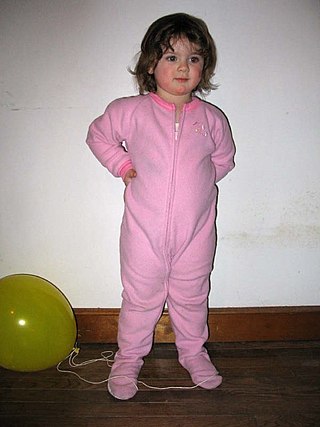
The blanket sleeper is a type of especially warm sleeper or footie pajama worn primarily during the winter in the United States and Canada. The garment is worn especially by young children.
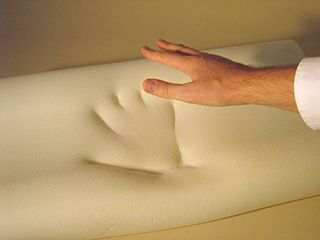
Memory foam consists mainly of polyurethane with additional chemicals that increase its viscosity and density. It is often referred to as "viscoelastic" polyurethane foam, or low-resilience polyurethane foam (LRPu). The foam bubbles or ‘cells’ are open, effectively creating a matrix through which air can move. Higher-density memory foam softens in reaction to body heat, allowing it to mold to a warm body in a few minutes. Newer foams may recover their original shape more quickly.

Goodnites are diapers designed for managing bedwetting. Goodnites are produced by Kimberly-Clark. The product has also been seen titled as Huggies Goodnites on official Huggies branded webpages.

A rubber glove is a glove made out of natural rubber or Synthetic rubber. The term 'rubber' refers to durable, waterproof and elastic material made from natural or synthetic latex. Rubber gloves can be unsupported or supported. Its primary purpose is protection of the hands while performing tasks involving chemicals. Rubber gloves can be worn during dishwashing to protect the hands from detergent and allow the use of hotter water. Sometimes caregivers will use rubber gloves during the diaper changing process to prevent contact with the child's fecal material/urine. Health professionals use medical gloves rather than rubber gloves when performing surgical operations.
An incontinence pad is a small, impermeable multi-layered sheet with high absorbency that is used in the incontinence and health-care industries as a precaution against fecal or urinary incontinence. It is generally made of cotton if washable, or paper if disposable. Incontinence diapers are a common incontinence pad. Incontinence pads are usually placed in an undergarment or on a bed or chair under a person. Incontinence pads are manufactured in light and heavy grades which offer a range of absorbencies, often referred to as a 'working capacity', which refers to the true absorbency an incontinence pad offers when in use. These sorts of pads can come as panty-liners, inserts, pads or even available as replacement underwear.
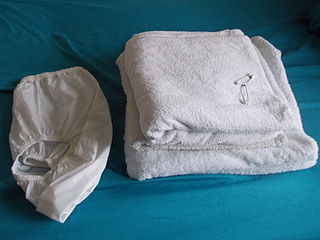
A cloth diaper or a cloth nappy, also known as reusable diaper or reusable nappy, is a diaper made from textiles such as natural fibers, human-made materials, or a combination of both. Cloth diapers are in contrast to disposable diapers, made from synthetic fibers and plastics. They are often made from industrial cotton which may be bleached white or left the fiber's natural color. Other natural fiber cloth materials include wool, bamboo, and unbleached hemp. Human-made materials such as an internal absorbent layer of microfiber toweling or an external waterproof layer of polyurethane laminate (PUL) may be used. Polyester fabrics microfleece or suedecloth are often used inside cloth diapers as a "stay-dry" wicking liner because of the non-absorbent properties of those synthetic fibers.

An electric blanket is a blanket that contains integrated electrical heating wires. Types include underblankets, overblankets, throws, and duvets. An electric underblanket is placed above the mattress and below the bottom bed sheet. This is the most common type in the UK and Commonwealth countries, where it is known by default as an "electric blanket"; in the U.S. and Canada, where it is less common, it is called an electric heated mattress pad. An electric overblanket is placed above the top bed sheet, and is the most common type in the U.S. and Canada, where it is called an "electric blanket".

A screen protector is an additional sheet of material—commonly polyurethane or laminated glass—that can be attached to the screen of an electronic device and protect it against physical damage.
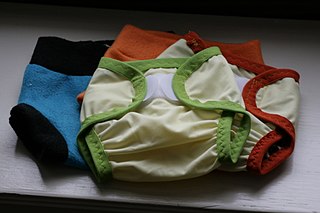
Polyurethane laminate is a compound fabric made by laminating a cloth fabric to one or both sides of a thin film of polyurethane. Polyurethane laminated fabrics have a wide range of applications in medical, automotive and garment uses.
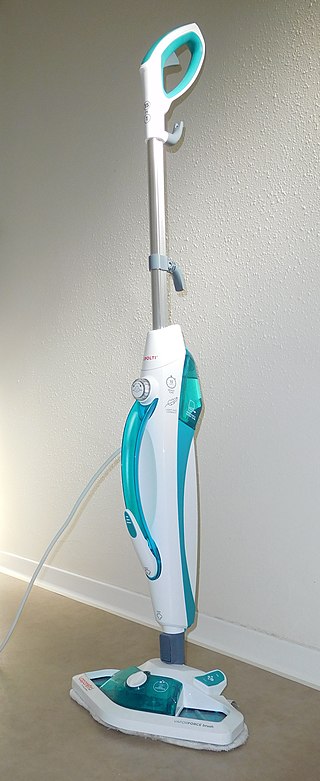
Vapor steam cleaners or steam vapor systems are cleaning appliances or devices that use steam to dry, clean, and sanitize surfaces. The steam is produced in a boiler that heats tap water to high temperatures to produce low-pressure, low moisture water vapor.

A mattress pad, mattress topper, or underpad is designed to lie atop a mattress. Made from a variety of materials including wool, cotton, memory foam, feather and latex, its function is to provide an extra layer of comfort, especially when the existing mattress is worn or uncomfortable.

Protect-A-Bed® is a manufacturer and distributor of bedding products(including mattress protectors, encasements, and pillows) that help protect against bed bugs, dust and allergens. Protect-A-Bed products are available in 45 countries. Protect-A-Bed supplies mattress and pillow protectors to 7 of the 11 top bedding specialists in the United States, several of the top 100 U.S. furniture chains, and all the major distributors in the pest control industry and hospitality industry. Protect-A-Bed products are also sold by national retailers including J.C. Penney, Target, Kohl’s, Costco, and Sears. The company currently has in excess of 7,000 furniture and bedding store clients in the United States as well as serving pest control and hospitality markets with bedding protection products. Protect-A-Bed is the developer of Miracle Membrane®, a proprietary membrane, which is waterproof and protects against liquids, as well as the patented BugLock® with SecureSeal® and three-sided zipper system for encasements. Protect-A-Bed products are listed as Class 1 Medical Devices with the Food and Drug Administration (Malaysia), and have received the Good Housekeeping Seal.

A bed skirt, sometimes spelled bedskirt, a bed ruffle, a dust ruffle in North America, a valance, or a valance sheet in the British Isles, is a piece of decorative fabric that is placed between the mattress and the box spring of a bed that extends to the floor around the sides. In addition to its aesthetics, a bed skirt is used to hide the ensemble fabric, wheels and other unsightly objects underneath the bed, or as protection against dust.

Dust mite allergy, also known as house dust allergy, is a sensitization and allergic reaction to the droppings of house dust mites. The allergy is common and can trigger allergic reactions such as asthma, eczema or itching. The mite's gut contains potent digestive enzymes that persist in their feces and are major inducers of allergic reactions such as wheezing. The mite's exoskeleton can also contribute to allergic reactions. Unlike scabies mites or skin follicle mites, house dust mites do not burrow under the skin and are not parasitic.

















